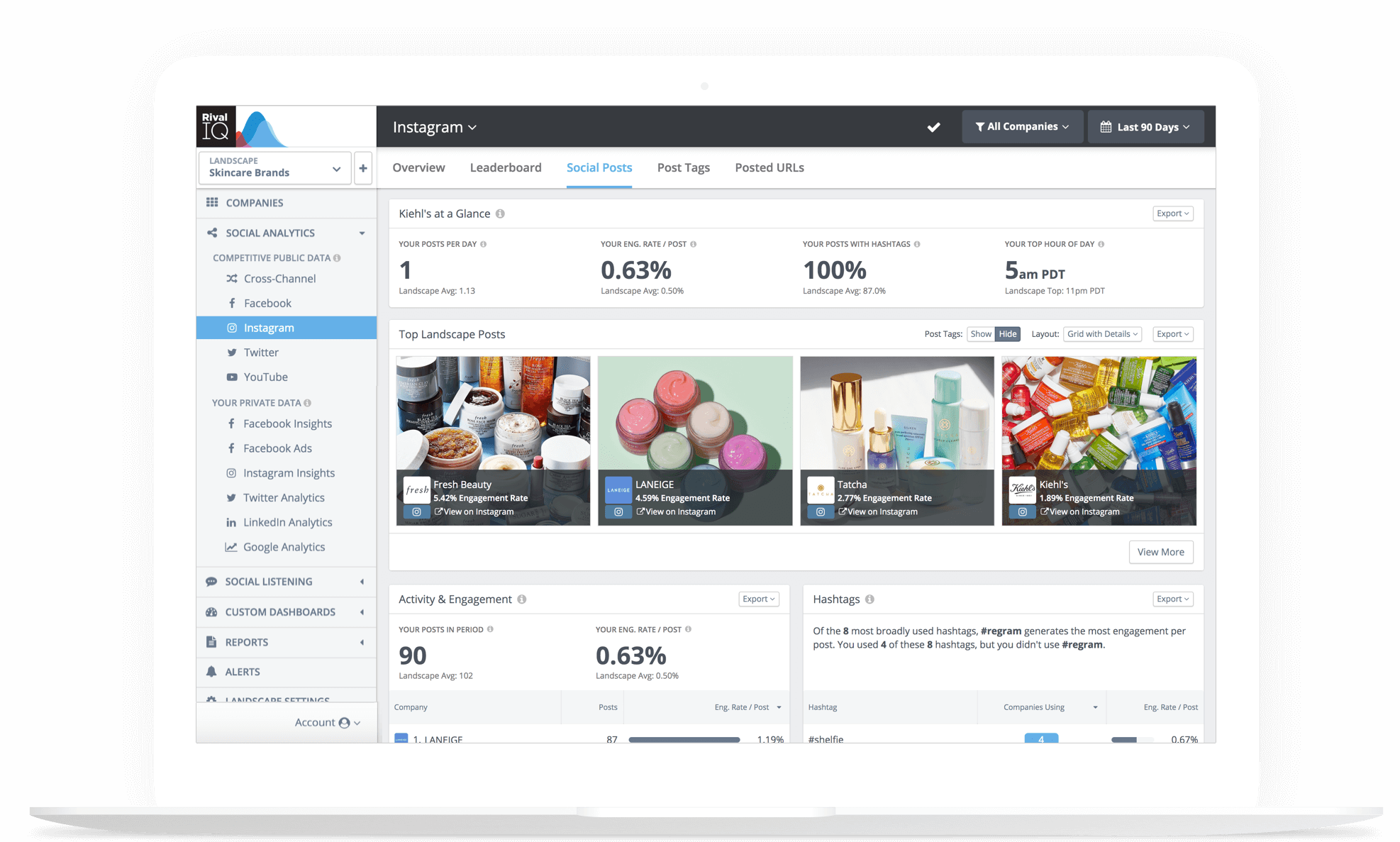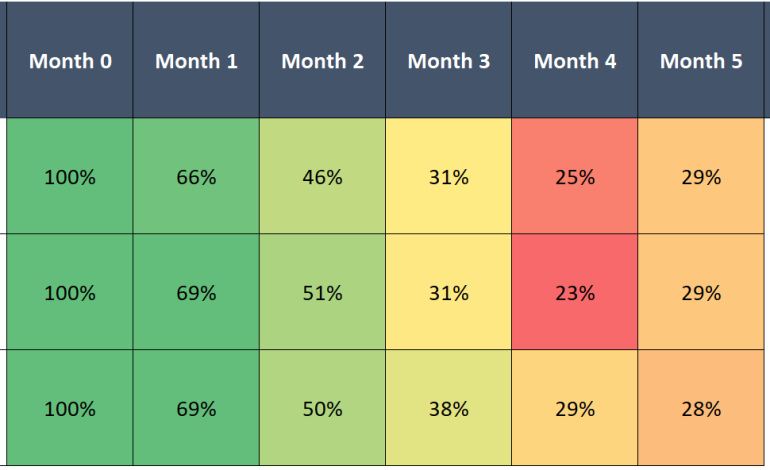You select the targets and goals you want your marketing efforts to achieve when developing your social media strategy. But how will you know whether you’re succeeding if you’re not keeping an eye on your social media analytics, stats, and performance?
Making wise company decisions and demonstrating return on investment (ROI) depends on social media analytics. Fortunately, almost all platforms come with native analytics. Additionally, there are several social media analytics tools available to assist you in keeping an even closer eye on your performance.
We’ll discuss the significance of social media analysis as well as the kinds of analytics you should be closely monitoring throughout this post. We’ll go over the social media analytics tools available to you to gauge your progress.
The process of gathering information and metrics to assess your overall success on social media is known as social media analytics. By doing this, marketers can better understand the kinds of social media material that appeal to their target demographic and modify their approach accordingly. Examining social media analytics reports gives teams the ability to make data-driven decisions about how to improve their marketing strategies and expand their companies.
Social media research can be done natively by marketers on sites like Instagram, TikTok, and X (previously known as Twitter). To delve further into the data, marketers may also employ social media management tools like Sprout.
Social media analytics help marketers with a number of tasks, from informing their strategy to planning campaigns and inspiring content ideas. There are five major benefits of tracking social analytics:
1. Trendspotting
Trendspotting is the act of pinpointing upcoming trends before they’re mainstream. Keeping a close eye on your social media analytics can help you do just that. Some of the trends that your social media analytics can help you determine include:
- Which platforms are gaining or losing traction and popularity
- Topics of interest that your audience is talking about (and brand mentions in conversations)
- Types of ads that interest your audience
- Rising influencers and products in your niche or industry
- Types of content that your audience engages with most
If analyzed properly, your social media analytics reports can be a huge help in identifying what you should post more of, what types of content are becoming more popular and what your audience wants to hear more about in the next quarter or year.
2. Brand sentiment
Brand sentiment illustrates how people feel about your brand. It includes all positive, neutral and negative feelings that are discussed online. By looking through your social media analytics, you can review and measure your brand sentiment through sentiment analysis software.
This helps ensure your audience is happy with your business and enables you to detect opportunities to make amends with unsatisfied customers. And you can uncover opportunities to improve your business.
For instance, through sentiment analysis you could discover your customers are asking the same questions about a particular product feature, enabling you to update your FAQ page or help center. Sentiment analysis can be used with competitor analysis because you can pinpoint new competitors and related topics your customers are buzzing about that you may have not considered before.
3. Value perception
Value perception (or perceived value) refers to the overall customer opinion of your brand’s product or service and whether or not it can meet their needs. Perceived value is key to determining demand and the price point of a product or service. For example, if your product has a low perceived value, customers won’t be willing to pay much for it.
You can measure value perception by using social listening tools and monitoring data from other digital marketing dashboards, such as Google Analytics. This can help guide the content you create to improve value perception and make sure you’re showcasing how your product or service can hit key pain points.
4. Setting social media goals
Social media analytics can also help you see which channels and content are performing well, so you can create actionable, realistic social media goals and objectives.
The key word here is realistic. If you take a look at your social media analytics reports and realize your Instagram account is growing by 10 followers per week, trying to jump from 5,000 followers to 10,000 followers in a single quarter is not a realistic goal, even if you revamp your posting strategy. You might instead try to make a goal where your account starts growing by 20 followers per week and steadily increase that goal from there.
5. Proving ROI
Finally, your social media analytics can help prove the ROI of your social media marketing efforts. Each time you run a new campaign, monitor your social analytics to see how the content is performing, if people are clicking over to your website and if you’re generating new sales. Doing this demonstrates social media ROI so teams can earn more buy-in and resources. UTM tracking and URL shortening are two ways that make proving ROI via analytics even easier. This way, you can attribute specific pipelines and purchases to your social media efforts.
What are the Best Social Media Analytics Tools?
There is a heap of social media analytics tools to choose from, but it’s all about finding the platform that fits the unique needs of your organization. Take a look at our top three suggestions:
1. Sprout Social
Sprout offers cross-channel social media analytics, enabling you to dig into your performance on a single network or compare results across various networks at once. Refining your content or business strategy is easy with Sprout’s automated, presentation-ready reports. Take your research further with custom reports personalized to your organization’s key performance indicators (KPIs).
Read Also: Predictive Analytics For Improving Marketing ROI
But that’s just the tip of the iceberg for our social media analytics. With Sprout’s Advanced Listening tool, you can conduct sentiment analysis and uncover data about your audience, share of voice and relevant topics. And with Tagger by Sprout Social, you can measure and maximize your influencer marketing ROI and optimize your social marketing efforts.

2. Google Analytics
Google Analytics isn’t solely for social analytics, but it’s a staple for social media practitioners and leaders. You can create reports to monitor:
- How your social media efforts drive web traffic and lead generation
- Which social networks fuel the most traffic
- Audience demographics
- ROI of your social media campaigns

3. Rival IQ
Rival IQ is another tool for customized social media analytics reports. The platform can help brands track their success across a number of social networks including YouTube. Rival IQ also provides competitor analysis, social listening, influencer tracking, hashtag analytics and social media audits. Rival IQ is a great option for businesses with multiple social media channels or agencies working with multiple clients.

Social Media Branding Strategies To Grow Your Audience
Success on social media requires strong branding, but doing it well isn’t always simple. You need to have unbreakable plans in place if you want to build strong branding throughout your social media channels.
Below, we will examine tested social media branding techniques that can assist you in expanding your following and creating a recognizable brand across Facebook, Instagram, and other platforms.
Let’s begin by going over some basic branding principles that all brands on social media ought to follow. After that, we’ll discuss a few of the less evident tactics.
1. Optimize your bio
Getting your bio right is key to establishing a good brand identity on social media. You can think of your bio as your first introduction to your followers, so it’s important that it conveys exactly what your brand offers, as well as your main brand message.
This is your opportunity to tell people exactly what your brand is all about, so be sure to use your limited amount of characters wisely.
When crafting your bio, select the most important information that you want new and existing followers to see every time they visit your page. Also, consider using emojis to draw attention to the information, but make sure you select emojis that fit in with your brand image.
2. Choose a brand name and create a logo
When building a brand on social media, it’s really important to choose a name and stick with it. Followers need to know how to search for your brand and how to refer to it in order for your brand to see real growth. Therefore, avoid changing your business name, or creating multiple accounts under different names.
Once you’ve decided on your name, you can then create a logo. Your logo will become synonymous with your brand, so make sure to choose colors and graphics that are in keeping with your brand image and the messages you’re trying to convey.
Creating a logo is really easy. You can pay a professional graphic designer, or you can design one yourself on sites like Canva. When designing your logo, try to think about color psychology. Different colors connote different feelings and ideas, so it’s a good idea to choose a color that is in keeping with your brand message.
In addition, tie your social media branding in with your brand identity on your website. Use the same brand name, colors and logos etc. This will create a sense of familiarity across different social media networks, and other platforms you’re featured on.
3. Develop your brand voice
The tone that you use within your writing on social media is known as a ‘voice’, and it’s super important to keep this voice consistent and suitable for your brand. The tone, or voice that you choose should reflect your brand and its values and be suitable for your target audience.
For example, if your target audience is young people, it might be appropriate to use slang terms and include internet memes and jokes within your writing. However, if your brand is a law firm, then you would probably want to keep your tone informative and professional.
Whatever voice you choose for your social media posts, it’s important to keep it consistent across all posts and on each social media channel. This will help to develop your branding and build a strong connection with your audience.
4. Make use of user-generated content
Engaging with your audience is a great way to improve brand sentiment and grow on social media. One of the easiest and most effective ways to do this is through the use of UGC. UGC stands for user-generated content, and it refers to content that has been created by followers and other social media users.
For example, social media users might purchase something from your brand post about it on Instagram, and tag your brand. You could then reshare this post to your own socials to create engagement opportunities with your followers and boost your own content output for the day.
This created tons of engagement between the brand and its followers and got people talking about the brand across different social media channels.
5. Create and join online communities
If you want to build a brand that has a personal connection with followers, then it’s a good idea to get involved in communities within your target audience or create your own. For example, if you are building a brand related to gaming, it may be worth joining Twitch or Discord communities where your target audience hangs out and chat.
You may also want to consider creating your own community groups online that can become a hub for followers old and new to meet each other and learn more about your products and upcoming events.
This social media branding strategy is particularly effective for smaller brands that find it hard to create a large social media presence and stand out.
6. Track post performance across platforms
When building your brand on social media, it’s important to know exactly how your posts are performing and how you can develop your strategy to gain more followers. To do this, you should try to track all of your activity on all the different social platforms to see if there are any trends emerging.
For example, you might find that your Instagram posts perform very well and have great reach, whereas your Twitter posts are receiving little to no engagement. This type of analysis will give you a better idea of which platforms your target audience likes to use and which platforms are best to try and focus on.
You can also track individual posts to see which ones perform the best and garner the most engagement. If you find that static image posts aren’t performing well, but video posts and stories generate lots of comments and engagement, then you can adapt your strategy accordingly.
If you’re using many different platforms, then it’s a good idea to invest in a social media analytics tool that will provide data and insights for all of your social media content, so that it’s easier to compare performance for different platforms and content types. Tools like Social Status and Agorapulse are great for this.
7. Monitor brand mentions
When growing your social media following, it’s a good idea to keep a close eye on what people are saying about your brand online.
You can use information about brand mentions to help guide your social media marketing strategy and to ensure that you are monitoring and managing any interactions that could harm your brand and its reputation. Brand monitoring is super easy with the help of tools like Brand24.
Simply sign up for the tool and input your brand names or related hashtags, and you’ll be able to view all mentions of your brand across social media, blogs, podcasts, and more. Basically, if your brand was mentioned on the internet, you’ll know about it!
You can also use brand monitoring tools to see if mentions of your brand are increasing or decreasing over time, and you can use them to gauge the success of social media campaigns.
For example, if you launch a UGC campaign, you can use brand monitoring to see if your mentions increased as a result.


